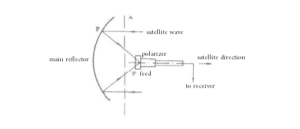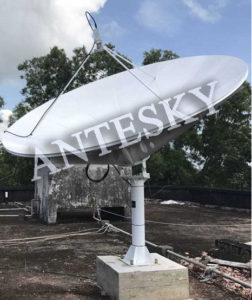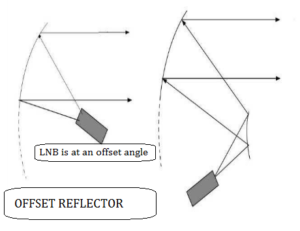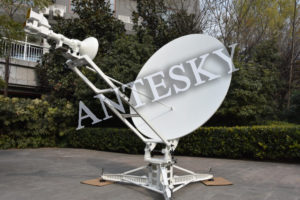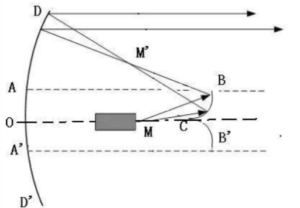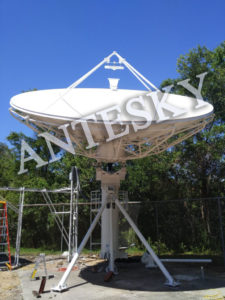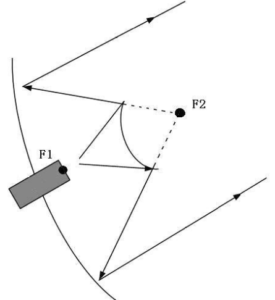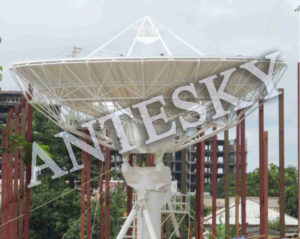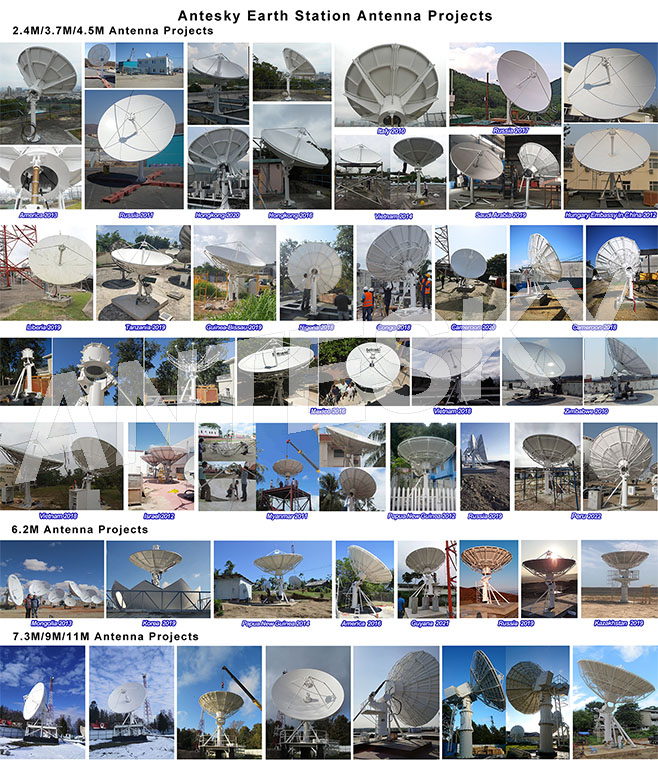
Generally, there are 4 types of parabolic antenna that mostly used in satellite communication industry including prime focus, offset, ring focus and Cassegrain. Well if you do not know the difference between them, then continue reading for sharing with you a brief introduction below for these types.
Prime focus antenna(The first antenna type)
Prime focus antenna(Normally for TVRO application)
The prime-focused satellite antenna is generally called a feed-forward antenna, also known as a parabolic antenna. No matter how deep or shallow, the curvature of the antenna reflector is parabolic. The prime focus antenna is characterized by a perfect circular panel, and the LNB is placed at the central focal point of the antenna. The prime focus is usually in the same plane as the most central point on the reflector itself. It can also be viewed as a concave reflector like the image above.
Normally it is for TVRO application to receive C band signals and is usually big in size like 3m, 3.7m, 4.5m, 6.2m…etc. You can view the below Antesky 3.0m TVRO antenna in Thailand for reference.
Antesky 3.0m TVRO antenna in Thailand
Offset antenna antenna(The second antenna type)
Offset antenna
(Normally for small fixed VSAT and portable flyaway antenna)
The offset feed antenna is relative to the prime feed antenna, which means that the positions of the feed and the LNB are not on a line perpendicular to the antenna center tangent and passing through the antenna focal point. Therefore, the offset feed antenna does not have the effect of feed shadow. At the same time, under the premise of the same antenna area, processing accuracy, and receiving frequency, the gain of the partial feed antenna is greater than that of the prime feed antenna. But whether it is a prime-feed antenna or a offset-feed antenna, they are all cross-sections of a rotating paraboloic, but the interception positions are different.
Offset dishes are usually small in size and are used to receive Ku band waves. It is mainly used for small fixed VSAT and portable flyaway antenna.This offset dishes have an advantage that they are cheaper, lighter and can be installed almost anywhere provided there is a clear view of the sky. Take one of 1.8 Meter Quick Deploy Fly Away VSAT Antenna projects for an example below.
1.8 Meter Quick Deploy Fly Away VSAT Antenna
Ring focus antenna(The third antenna type)
Ring focus antenna
(Normally for 2.4m,3m,3.7m,4.5m and 6.2m size Tx/Rx antenna)
The ring focus antenna is composed of a main reflector, a sub-reflector and a feed horn. The structure is shown in the figure above.
The main reflector is a partially rotating parabolic surface; the sub reflector is composed of an elliptical arc CB rotating around the main reflector axis OC once, and the feed horn is located at a focal point M of the rotation ellipsoid surface. The radio waves radiated by the feed are reflected by the sub reflector surface and converge on another focal point M ‘of the ellipsoid surface. M’ is the focal point of the parabolic surface OD. The radio waves reflected by the primary mirror reflector are emitted in parallel. Since the antenna is a rotating body around the mechanical axis, the focal point M ‘forms a ring perpendicular to the antenna axis, so this antenna is called a ring focus antenna.
The ring focus design can eliminate the sub reflector from blocking the radio waves, and can also basically eliminate the sub reflector from facing the feed horn. The close design of the feed horn and the sub reflector is beneficial to reduce the side lobe and VSWR of the antenna in a wide frequency band and improve the antenna efficiency.
Because the general requirements for satellite communication antennas are lower side lobes and higher G / T values in a wide frequency band, the use of ring-focus antennas can meet these requirements at the same time, so ring-focus antennas are commonly used with small VSAT earth stations. We have done Antesky 6.2Meter Tx/Rx Antenna 6.2m for your reference.
6.2m Tx. Rx. VSAT antenna
Cassegrain antenna(The forth antenna type)
Cassegrain antenna
(Normally for big size antenna,like 7.3m,9m,11m,13m,16m,18m…etc)
Cassegrain antenna is a kind of dual-reflector antenna and composed of two reflectors and a feed shown above figure. The main reflector is a rotating parabolic surface, sub-reflector is rotate Hyperboloid ; the feed is located in the focal F1 of the rotate Hyperboloid, the focal of parabolic is coincide with rotate Hyperboloid, that is the F2. The wave from feed is radiated to main reflector by the sub reflector, and re-radiated on the main reflector. Since the focal on the main reflector is coincide with the focal on sub reflector, and re-radiated twice on the main reflector, the radio waves are directed and radiated parallel to the opposite direction of the parabola.
Cassegrain antenna is a parabolic antenna in which the feed antenna is mounted at or behind the surface of the concave main parabolic reflector dish and is aimed at a smaller convex sub reflector suspended in front of the primary reflector. The beam of radio waves from the feed illuminates the secondary reflector, which reflects it back to the main reflector dish, which reflects it forward again to form the desired beam. The Cassegrain design is widely used in parabolic antennas, particularly in large antennas like 7.3m,9m,11m,13m,16m,18m…etc. such as those in satellite ground stations, radio telescopes, and communication satellites. Take our 11.3M big satellite Cassegrain dish in Myanmar for your reference.
We believe by now you know more that some basic knowledge for antenna type from the above. If you’d like to learn further about antenna via our website, or you can send us an inquiry directly at sales@antesky.com.

